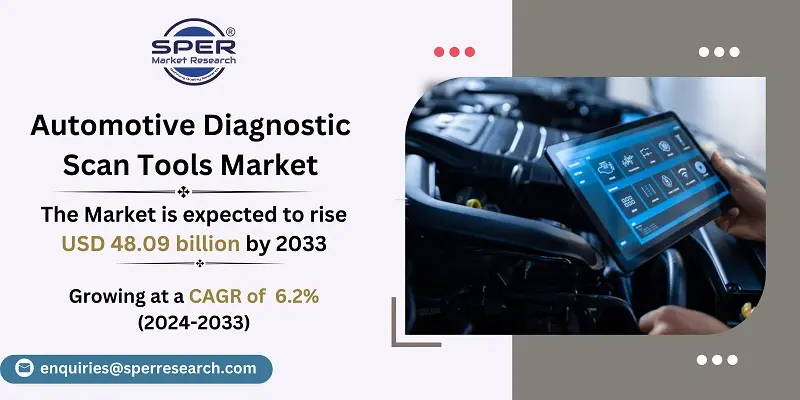
Automotive Diagnostic Scan Tools Market Growth, Size, Trends, Demand, Share and Future Outlook
Automotive Diagnostic Scan Tools Market Size- By Handheld Scan Tools, By Offering Type, By Connectivity- Regional Outlook, Competitive Strategies and Segment Forecast to 2033
| Published: Mar-2024 | Report ID: AMIN2487 | Pages: 1 - 210 | Formats*: |
| Category : Automotive & Transportation | |||
- 2022: In order to streamline the car repair and maintenance process, Reparify has introduced the new asTech all-in-one solution for local and remote automotive diagnostic, calibration, and detailed programming tools.
- 2023: Opus IVS, the industry leader in automobile diagnostic instruments and services, has partnered strategically with CARS Co-Op Network, an auto body and collision repair shop. Through the cooperation, the firms' diagnostic skills would support each other's growth.


| Report Metric | Details |
| Market size available for years | 2020-2033 |
| Base year considered | 2023 |
| Forecast period | 2024-2033 |
| Segments covered | By Handheld Scan Tools, By Offering Type, By Connectivity |
| Regions covered | North America, Asia-Pacific, Latin America, Middle East & Africa and Europe |
| Companies Covered | ACTIA Group, Continental AG, Delphi Technologies, Denso Corporation, Horiba Ltd, KPIT Technologies Ltd, Robert Bosch GmbH, Siemens AG, Snap-on Incorporated and Softing AG. |
- Automotive Manufacturers
- Automotive Technicians and Mechanics
- Automotive Parts Suppliers
| By Handheld Scan Tools: |
|
| By Offering Type: |
|
| By Connectivity: |
|
- Global Automotive Diagnostic Scan Tools Market Size (FY’2024-FY’2033)
- Overview of Global Automotive Diagnostic Scan Tools Market
- Segmentation of Global Automotive Diagnostic Scan Tools Market By Handheld Scan Tools (Battery Analyzer, Code Readers, Digital Pressure tester, Scanners and Tpms Tools.)
- Segmentation of Global Automotive Diagnostic Scan Tools Market By Offering Type (Diagnostic Equipment/Hardware and Diagnostic Software.)
- Segmentation of Global Automotive Diagnostic Scan Tools Market By Connectivity (Bluetooth, USB and WI-FI)
- Statistical Snap of Global Automotive Diagnostic Scan Tools Market
- Expansion Analysis of Global Automotive Diagnostic Scan Tools Market
- Problems and Obstacles in Global Automotive Diagnostic Scan Tools Market
- Competitive Landscape in the Global Automotive Diagnostic Scan Tools Market
- Impact of COVID-19 and Demonetization on Global Automotive Diagnostic Scan Tools Market
- Details on Current Investment in Global Automotive Diagnostic Scan Tools Market
- Competitive Analysis of Global Automotive Diagnostic Scan Tools Market
- Prominent Players in the Global Automotive Diagnostic Scan Tools Market
- SWOT Analysis of Global Automotive Diagnostic Scan Tools Market
- Global Automotive Diagnostic Scan Tools Market Future Outlook and Projections (FY’2024-FY’2033)
- Recommendations from Analyst
1.1. Scope of the report1.2. Market segment analysis
2.1. Research data source2.1.1. Secondary Data2.1.2. Primary Data2.1.3. SPER’s internal database2.1.4. Premium insight from KOL’s2.2. Market size estimation
2.2.1. Top-down and Bottom-up approach2.3. Data triangulation
4.1. Driver, Restraint, Opportunity and Challenges analysis4.1.1. Drivers4.1.2. Restraints4.1.3. Opportunities4.1.4. Challenges4.2. COVID-19 Impacts of the Global Automotive Diagnostic Scan Tools Market
5.1. SWOT Analysis5.1.1. Strengths5.1.2. Weaknesses5.1.3. Opportunities5.1.4. Threats5.2. PESTEL Analysis5.2.1. Political Landscape5.2.2. Economic Landscape5.2.3. Social Landscape5.2.4. Technological Landscape5.2.5. Environmental Landscape5.2.6. Legal Landscape5.3. PORTER’s Five Forces5.3.1. Bargaining power of suppliers5.3.2. Bargaining power of buyers5.3.3. Threat of Substitute5.3.4. Threat of new entrant5.3.5. Competitive rivalry5.4. Heat Map Analysis
6.1. Global Automotive Diagnostic Scan Tools Market Manufacturing Base Distribution, Sales Area, Product Type6.2. Mergers & Acquisitions, Partnerships, Product Launch, and Collaboration in Global Automotive Diagnostic Scan Tools Market
7.1. Global Automotive Diagnostic Scan Tools Market Value Share and Forecast, By Handheld Scan Tools, 2024-20337.2. Battery Analyzer7.3. Code Readers7.4. Digital Pressure tester7.5. Scanners7.6. Tpms Tools
8.1. Global Automotive Diagnostic Scan Tools Market Value Share and Forecast, By Application, 2024-20338.2. Diagnostic Equipment/Hardware8.3. Diagnostic Software
9.1. Global Automotive Diagnostic Scan Tools Market Value Share and Forecast, By End User, 2024-20339.2. Bluetooth9.3. USB9.4. WI-FI
10.1. Global Automotive Diagnostic Scan Tools Market Size and Market Share
11.1. Global Automotive Diagnostic Scan Tools Market Size and Market Share By Handheld Scan Tools (2020-2026)
11.2. Global Automotive Diagnostic Scan Tools Market Size and Market Share By Handheld Scan Tools (2027-2033)
12.1. Global Automotive Diagnostic Scan Tools Market Size and Market Share By Offering Type (2020-2026)
12.2. Global Automotive Diagnostic Scan Tools Market Size and Market Share By Offering Type (2027-2033)
13.1. Global Automotive Diagnostic Scan Tools Market Size and Market Share By Connectivity (2020-2026)13.2. Global Automotive Diagnostic Scan Tools Market Size and Market Share By Connectivity (2027-2033)
14.1. Global Automotive Diagnostic Scan Tools Market Size and Market Share By Region (2020-2026)14.2. Global Automotive Diagnostic Scan Tools Market Size and Market Share By Region (2027-2033)14.3. Asia-Pacific14.3.1. Australia14.3.2. China14.3.3. India14.3.4. Japan14.3.5. South Korea14.3.6. Rest of Asia-Pacific14.4. Europe14.4.1. France14.4.2. Germany14.4.3. Italy14.4.4. Spain14.4.5. United Kingdom14.4.6. Rest of Europe14.5. Middle East and Africa14.5.1. Kingdom of Saudi Arabia14.5.2. United Arab Emirates14.5.3. Rest of Middle East & Africa14.6. North America14.6.1. Canada14.6.2. Mexico14.6.3. United States14.7. Latin America14.7.1. Argentina14.7.2. Brazil14.7.3. Rest of Latin America
15.1. ACTIA Group15.1.1. Company details15.1.2. Financial outlook15.1.3. Product summary15.1.4. Recent developments15.2. Continental AG15.2.1. Company details15.2.2. Financial outlook15.2.3. Product summary15.2.4. Recent developments15.3. Delphi Technologies15.3.1. Company details15.3.2. Financial outlook15.3.3. Product summary15.3.4. Recent developments15.4. Denso Corporation15.4.1. Company details15.4.2. Financial outlook15.4.3. Product summary15.4.4. Recent developments15.5. Horiba Ltd15.5.1. Company details15.5.2. Financial outlook15.5.3. Product summary15.5.4. Recent developments15.6. KPIT Technologies Ltd15.6.1. Company details15.6.2. Financial outlook15.6.3. Product summary15.6.4. Recent developments15.7. Robert Bosch GmbH15.7.1. Company details15.7.2. Financial outlook15.7.3. Product summary15.7.4. Recent developments15.8. Siemens AG15.8.1. Company details15.8.2. Financial outlook15.8.3. Product summary15.8.4. Recent developments15.9. Snap-on Incorporated15.9.1. Company details15.9.2. Financial outlook15.9.3. Product summary15.9.4. Recent developments15.10. Softing AG15.10.1. Company details15.10.2. Financial outlook15.10.3. Product summary15.10.4. Recent developments15.11. Others
SPER Market Research’s methodology uses great emphasis on primary research to ensure that the market intelligence insights are up to date, reliable and accurate. Primary interviews are done with players involved in each phase of a supply chain to analyze the market forecasting. The secondary research method is used to help you fully understand how the future markets and the spending patterns look likes.
The report is based on in-depth qualitative and quantitative analysis of the Product Market. The quantitative analysis involves the application of various projection and sampling techniques. The qualitative analysis involves primary interviews, surveys, and vendor briefings. The data gathered as a result of these processes are validated through experts opinion. Our research methodology entails an ideal mixture of primary and secondary initiatives.



Frequently Asked Questions About This Report
PLACE AN ORDER
Year End Discount
Sample Report
Pre-Purchase Inquiry
NEED CUSTOMIZATION?
Request CustomizationCALL OR EMAIL US
100% Secure Payment






Related Reports
Our Global Clients
Our data-driven insights have influenced the strategy of 200+ reputed companies across the globe.




















